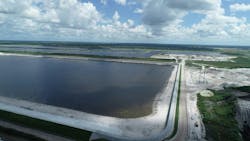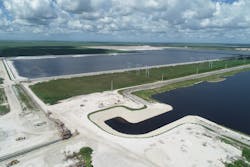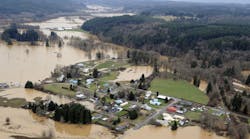Collaborative project converts quarry into sustainable water resource for eight utilities
Florida's water utilities face complex challenges to provide fresh, clean water to their customers. Issues range from saltwater intrusion to tapped out aquifers to brackish water expansion, all amid an array of environmental concerns. A group of Southeast Florida water agencies and private companies had the foresight more than a decade ago to begin developing an alternative water supply source that would be resilient, sustainable and affordable. The collaborative result is the C-51 Reservoir Project Phase 1, located near Loxahatchee, Florida. The $161 million project resides in a former limestone quarry owned by Palm Beach Aggregates LLC. The company first proposed the idea for turning the area into a stormwater collection and distribution reservoir and worked with water utilities in the region to gain their participation. Black & Veatch was the Engineer of Record for the final design of the reservoir and associated control structures, and it provided engineering during the construction, construction management, and construction quality assurance/quality control phases for the project. The construction contractor was Phillips & Jordan.
The project won the Engineering Excellence Award from the American Council of Engineering Companies of Florida, and it has now been entered into the national competition. The project occupies 450 acres and captures stormwater that was formerly lost to the Lake Worth Lagoon estuary. With construction lasting from 2020 to 2023, the project has a storage capacity of 14,000 acre-feet and allows for utility withdrawals of 35 million gallons per day of raw water by eight participating water utilities across three counties. The participating utilities are the City of Sunrise, Hallandale Beach, City of Margate, Pompano Beach, Broward County, Dania Beach, City of Fort Lauderdale and Miami- Dade County. Water is conveyed to these utilities via an existing canal network, and the reservoir is managed and operated by the South Florida Water Management District.
A multitude of benefits
The system has multiple social and economic benefits designed into it. It is an innovative alternative water supply resource that reuses stormwater for aquifer recharge and ground water supply augmentation. This purposeful watershed management allows for the release of excess stormwater at the right time and with the right quantity during periods of low water availability. It serves as a tool for flood risk management by storing runoff flows during major rainfall events, thereby attenuating flows downstream. In addition, the project assists with coastal ecosystem restoration by capturing excess stormwater flows, thereby reducing poor quality, nutrient-laden flows to the Lake Worth Lagoon, the Everglades and Biscayne Bay. This allows for overall ecosystem restoration in South Florida.
Innovative construction
The ability to build a below-grade storage reservoir was made possible due to the geological makeup of the limestone. Normally, limestone is quite permeable, but in this isolated region, the limestone is extraordinarily tight, providing the necessary foundation conditions for a below-grade reservoir.
One of the key components in the project was the construction of a 48-foot deep soil bentonite cutoff wall (SBCW) to control seepage. This seepage barrier wall is about four miles long and required pre-blasting and pre-trenching of the limestone layer before SBCW construction. Pre-blasting was also required in the control structure foundations and the conveyance channel. The pre-blasting had to contend with a major power transmission line, underground gas line, and the adjacent reservoir, known as the L-8 Flood Equalization Basin (FEB), located a few hundred feet from the work area. The project utilized a very experienced blasting contractor, using well-designed controlled blasts. Blast numerical models were developed to design the blast pattern and energy in sensitive areas. Accelerometers, settlement points, and pre- and post-blast surveys were used to make sure surrounding infrastructure remained safe and unharmed. The instrumentation results were also used to calibrate and refine the blast models as the work advanced.
Roller Compacted Concrete (RCC) was extensively used during the reservoir dam construction. The majority of the 20,000 lineal feet (lf) of perimeter embankment surrounding the reservoir consists of an earthen dam with an RCC overlay on the interior slope to provide erosion control against waves. However, approximately 6,000 lf of the perimeter embankment is a full RCC section due to space constraints. Full RCC dam sections have been used in many other regions in the past; this one is unique for Florida. To avoid the extreme heat of South Florida, the RCC placement was accomplished mostly at night, creating additional logistical and safety challenges. The C-51 Reservoir is connected to the adjacent L-8 FEB, and the two reservoirs operate in tandem. Water is withdrawn from the L-8 Canal located adjacent to the L-8 FEB to fill both reservoirs. Similarly, a pump station within the L-8 FEB is used to discharge water from both reservoirs back into the L-8 Canal. The new intake/ outlet control structure connecting the two reservoirs consists of a control structure and gates located south of the L-8 FEB, along with two 8-foot diameter fiberglass pipes tunneled through the corridor between the two reservoirs. Micro-tunneling was used to construct the twin 1,000-foot connections, again a unique construction design for this region.
To construct the two tunnels, the giant pipes had to be hydraulically pushed immediately behind the cutting head of the tunnel boring machine. This required a large and stout jacking pit built within the C-51 Reservoir. But the costs associated with the jacking pit were mitigated by designing the pit to be “recycled” to become the water intake/discharge structure for the pipes — just another innovative and cost-saving approach to this project.
Building During the Pandemic
Construction began in early 2020, and by March of that year, the entire world was dealing with an unprecedented lockdown of business and commerce due to the COVID-19 pandemic. Supply chain issues immediately arose, yet they only prompted the team to work more closely to solve extraordinary challenges.
“Shortly after commencement of construction, as a result of the COVID-19 global pandemic and resulting supply chain issues, a significant redesign effort of the gated control structure became necessary,” said Albert Moragues, vice president of Palm Beach Aggregates. “The project team worked through all of these issues in a collaborative manner with the owner, contractor and agencies to obtain all approvals, integrate with ongoing construction and successfully complete the project.”
The project was finished in October 2023 — within budget, despite the delays. As the prime design consultant, Black & Veatch led the engineering effort during the construction phase. This included final design of all control structures; hydraulic safety evaluation; quality control services, including field inspections and materials testing utilizing an on-site Construction Materials Engineering Council (CMEC) certified laboratory; experienced team of engineering inspection staff; and full-time resident construction managers.
Cost Savings Compared to Alternatives
Not to be lost, this solution saves a significant amount of money compared to alternative solutions to the issue of water demand. By utilizing the already excavated, below-grade mining pits, the C-51 Reservoir is a low-hazard dam, compared to the high-hazard dams that other projects require. This solution was also less expensive compared to other options, such as building multiple reverse-osmosis membrane water treatment facilities or doing extensive pumping of well fields.
This effort involved dozens of agencies and private companies — all coming together to create an affordable solution that will yield benefits for decades to come. During the wet season, the C-51 Reservoir takes in water for storage, and during the dry season, returns it to the L-8 Reservoir and routes it out the South Florida canal network, thereby allowing the eight water utilities to increase their water withdrawals.
This project was made possible by the vision of Palm Beach Aggregates LLC, which first proposed the plan and then worked over many years to see it through completion. As limestone mining continues in the immediate area, plans are in the works for future phases of water reservoir construction, potentially tripling the total reservoir capacity, which will only better ensure quality water supplies for the residents of South Florida.
About the Author
Jeff Beriswill
Southeast Dams practice leader
Jeff Beriswill, P.E., is Southeast Dams practice leader at Black & Veatch. Beriswill can be reached at [email protected].



